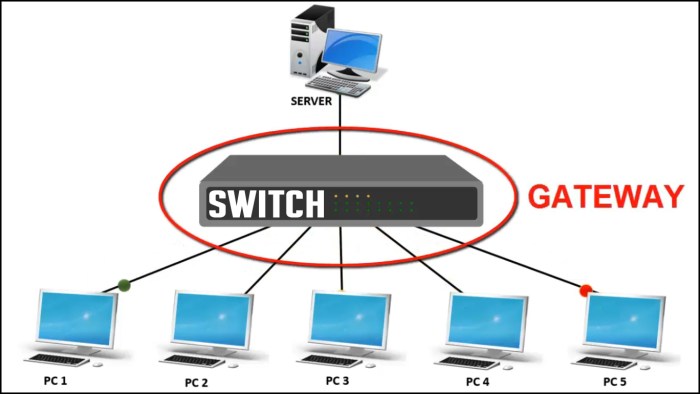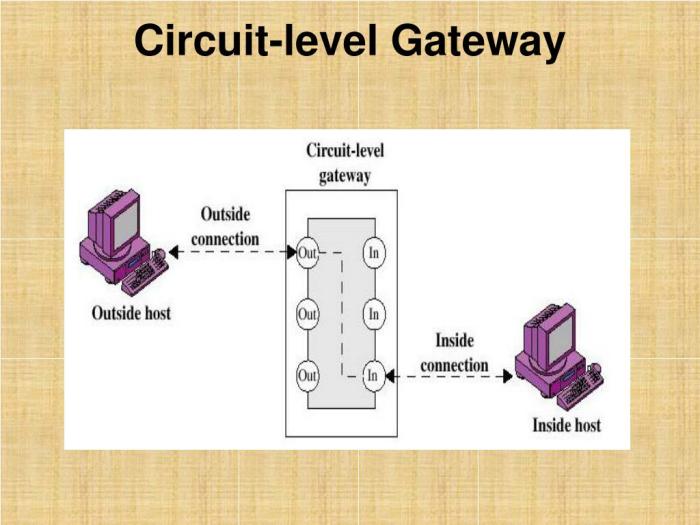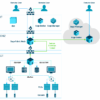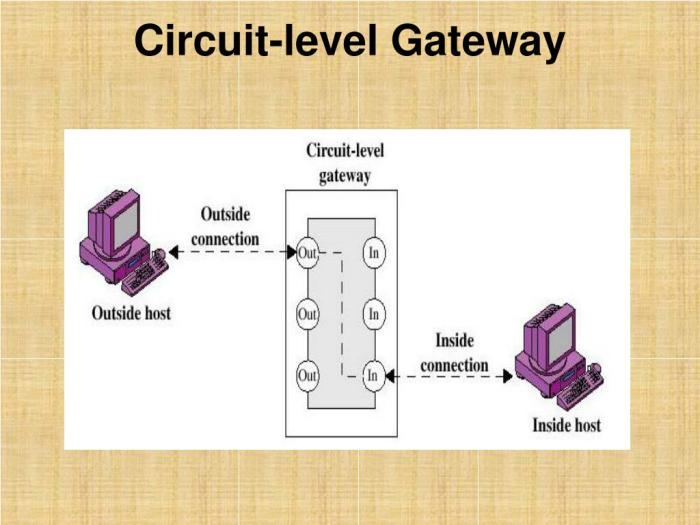What is a circuit level gateway? It’s a crucial component in network communication, acting as a gatekeeper for establishing and managing connections between networks. Imagine it as a dedicated server overseeing the flow of data between systems, ensuring smooth and secure transmission. This detailed exploration dives into the intricacies of circuit-level gateways, covering their definition, operation, security considerations, and comparison with other gateway types.
Understanding the mechanisms behind circuit-level gateways is essential for anyone working with network architectures. This guide will cover the technical aspects of how they function, highlighting the steps involved in a connection process, the protocols they handle, and the data flow patterns. It will also Artikel various security considerations and how to protect them from potential threats.
Definition and Purpose
A circuit-level gateway acts as a crucial intermediary in network communication, facilitating the smooth exchange of data between different networks or systems. It operates at a lower level than application-level gateways, focusing on managing the established connections rather than the content of the data itself. This approach makes it efficient for handling large volumes of data, often seen in streaming applications or other high-throughput scenarios.Its fundamental purpose is to translate and manage the communication protocols between networks or systems.
This involves establishing and maintaining the necessary channels for data transfer, ensuring data integrity, and adapting to varying network architectures. It is a critical component in environments with complex network topologies and diverse communication protocols.
Circuit-Level Gateway Definition
A circuit-level gateway is a network component that operates at the transport layer of the OSI model. It establishes and manages a connection between two or more networks, primarily focusing on the circuit-level communication. This involves setting up the necessary channels and managing the flow of data through those channels. It’s essentially a specialized router that focuses specifically on the ongoing communication between endpoints.
Key Functionalities
Circuit-level gateways typically perform the following functions:
- Connection Management: They establish, maintain, and terminate connections between different networks or systems. This is crucial for ensuring reliable and consistent communication. This includes handling connection establishment procedures, maintaining connection states, and gracefully closing connections when necessary.
- Protocol Translation: They can translate between different communication protocols used by various networks. For instance, a gateway might convert TCP connections to UDP connections, adapting to the specific requirements of different systems.
- Security Filtering: They can apply security measures to the connections, such as access control and authentication. This protects the network resources from unauthorized access and maintains data integrity.
- Network Address Translation (NAT): Circuit-level gateways can often handle NAT, translating private IP addresses into public ones for communication over the internet. This is essential for hiding internal network structures from external users.
Comparison with Application-Level Gateways, What is a circuit level gateway
A crucial distinction lies in their operating level. Circuit-level gateways operate at the transport layer, focusing on the communication channel itself. In contrast, application-level gateways operate at the application layer, scrutinizing and modifying the data exchanged between applications. This means circuit-level gateways are less concerned with the actual data being transmitted, while application-level gateways are heavily involved in inspecting and potentially altering the data content.
Analogy
Imagine a phone call. The circuit-level gateway is like the phone switchboard operator. It establishes the connection between two parties, ensures the line remains open during the call, and handles the signaling needed to maintain the conversation. It doesn’t care about the content of the conversation, only that the connection is maintained. An application-level gateway, in this analogy, would be like a translator who listens to the conversation and translates parts of it if needed.
Mechanism and Operation
Circuit-level gateways, unlike application-level gateways, operate at a deeper level, managing the connection itself. This approach provides enhanced security and control over communication flows. Understanding the mechanism behind connection establishment and maintenance, and the protocols involved, is crucial for comprehending their functionality. This section delves into the intricacies of circuit-level gateways.Circuit-level gateways act as intermediaries, establishing and maintaining the communication channels between two parties.
They are responsible for the entire process of setting up a connection, ensuring data integrity, and overseeing the transfer of data packets. This intricate process ensures a secure and reliable connection between networks.
Connection Establishment Mechanism
The process of establishing a connection typically involves a three-way handshake. First, a connection request is initiated by one party, typically a client. This request is forwarded by the gateway to the destination server. Subsequently, the server acknowledges the request, and finally, the gateway confirms the connection with the client, completing the handshake. This structured approach guarantees a reliable and established connection.
Steps in Connection Process
A circuit-level gateway handles the connection process in a sequence of well-defined steps.
- Connection Request: The client initiates a connection request, typically through a TCP handshake. This initial message specifies the destination and other necessary parameters.
- Gateway Interception: The circuit-level gateway intercepts the connection request, validating its legitimacy.
- Verification and Forwarding: The gateway verifies the request against security policies and then forwards it to the intended destination.
- Server Response: The server responds to the request, acknowledging the connection attempt.
- Gateway Confirmation: The gateway confirms the connection to the client, signaling the successful establishment of the communication channel.
- Data Transfer: Once the connection is established, data transfer can commence, managed and monitored by the gateway.
Protocols Handled
Circuit-level gateways predominantly handle TCP (Transmission Control Protocol) connections. This is because TCP provides reliable, ordered, and error-checked data transmission, essential for maintaining consistent communication. While other protocols might be utilized for specific tasks, TCP remains the cornerstone for most circuit-level gateway operations.
Data Flow Through the Gateway
Data flows through a circuit-level gateway in a well-defined manner. The gateway acts as a conduit, receiving data from the originating client, processing it according to its configuration, and forwarding it to the destination server. Similarly, data flowing from the server to the client is processed and relayed by the gateway. This controlled flow ensures security and efficient management of data transmission.
Components Involved
The following table Artikels the key components involved in a circuit-level gateway’s operation.
| Component | Description |
|---|---|
| Client | The initiating entity requesting a connection. |
| Gateway | The intermediary that establishes and maintains the connection. |
| Server | The destination entity responding to the connection request. |
| Security Policies | Rules and regulations governing access and data transfer. |
| Protocol Handlers | Components responsible for handling specific communication protocols. |
Security Considerations
Circuit-level gateways, while offering a straightforward approach to network connectivity, present specific security vulnerabilities. Understanding these risks and implementing appropriate safeguards is crucial for maintaining the integrity and confidentiality of network communications. A robust security posture for a circuit-level gateway is not just about preventing attacks; it’s about proactively mitigating potential threats and ensuring reliable operation.
Vulnerabilities of Circuit-Level Gateways
Circuit-level gateways operate at a lower layer of the network stack, primarily handling connection establishment and forwarding. This limited context makes them susceptible to specific vulnerabilities. A key weakness lies in their limited ability to inspect the data flowing through them. This lack of inspection makes them vulnerable to attacks that exploit the connection itself, rather than the data content.
Circuit-level gateways act as intermediaries, handling network communication at a low level. Think of them as the gatekeepers of data packets, ensuring smooth traffic flow. This is quite different from the complex work being done by TikTok, who will test a standalone content management app here. Ultimately, though, both processes, whether dealing with individual packets or entire content management systems, rely on similar principles of efficient data transfer and security to function effectively.
Common Security Threats
Several threats target circuit-level gateways. Denial-of-service (DoS) attacks, aiming to overwhelm the gateway with excessive connection requests, are a primary concern. Unauthorized access attempts, seeking to compromise the gateway’s administrative functions, are another critical threat. Exploiting vulnerabilities in the gateway’s underlying operating system or network protocols can also lead to significant security breaches.
Security Measures for Circuit-Level Gateways
Implementing robust security measures is paramount. Firewalls are essential to control incoming and outgoing traffic, preventing unauthorized access attempts and DoS attacks. Implementing strong authentication mechanisms, such as multi-factor authentication, is vital for protecting administrative access. Regular security audits and vulnerability assessments help identify and address potential weaknesses. Employing intrusion detection and prevention systems (IDS/IPS) can further bolster security by monitoring network traffic for malicious activity.
Configuring Circuit-Level Gateways for Enhanced Security
Proper configuration is crucial for securing a circuit-level gateway. Strict access controls, limiting access to only authorized users, are paramount. Utilizing strong passwords and enforcing password policies significantly reduce the risk of unauthorized access. Regular updates to the gateway’s software and operating system address known vulnerabilities, a crucial security practice. Enabling logging mechanisms for all activity allows for thorough auditing and rapid identification of suspicious events.
Security Protocols for Integration
Integrating specific security protocols with the gateway enhances its protection. IPsec (Internet Protocol Security) provides secure communication channels by encrypting and authenticating network traffic. SSH (Secure Shell) is a powerful tool for secure remote access to the gateway. Implementing TLS/SSL (Transport Layer Security/Secure Sockets Layer) encrypts the communication between the gateway and clients, preventing eavesdropping. These protocols work in conjunction with the gateway’s other security measures, providing a layered defense against potential threats.
Comparison with Other Gateways: What Is A Circuit Level Gateway
Circuit-level gateways, while specialized, exist within a broader ecosystem of network gateways. Understanding their position relative to packet-level and application-level gateways provides crucial context for their appropriate use. A clear comparison highlights their strengths and weaknesses, allowing informed decisions about the most suitable gateway type for specific network needs.
A circuit-level gateway acts like a translator between different network connections, ensuring smooth communication. It’s like a personal assistant for your data, making sure everything flows smoothly. Finding concert recommendations using Shazam on your iOS or iPhone, for example, shazam concert recommendations ios iphone , relies on several circuit-level gateways working behind the scenes. These gateways translate the requests and responses, allowing you to effortlessly enjoy that next gig.
This all happens within the background, which ultimately makes your experience seamless. In short, a circuit-level gateway is crucial for smooth network operations.
Circuit-Level vs. Packet-Level Gateways
Circuit-level gateways operate at a lower level than packet-level gateways. They focus on managing the connection itself, ensuring communication flow between two points. In contrast, packet-level gateways, often acting as proxies, examine and potentially modify each individual packet traversing the network. A key difference lies in their handling of network protocols. Circuit-level gateways primarily manage the underlying connection, while packet-level gateways scrutinize the contents of individual packets, including headers and payloads.
This nuanced approach allows packet-level gateways to perform more sophisticated filtering and routing tasks, such as firewalls, network address translation, and deep packet inspection. Circuit-level gateways are less versatile, lacking the detailed packet-level analysis capabilities. However, their efficiency in maintaining a persistent connection can be beneficial in specific situations.
Circuit-Level vs. Application-Level Gateways
Application-level gateways operate at the highest level of the network stack, interacting directly with applications. They handle the intricacies of specific application protocols, such as HTTP or FTP. In contrast, circuit-level gateways operate at a lower level, managing the communication channel between the applications, without direct interaction with the specific application protocol. This difference in operating level directly affects their functionality.
Application-level gateways can perform application-specific security checks, such as authentication and authorization, which circuit-level gateways cannot. They also have the potential for more complex transformations and manipulations of the data stream, including content filtering and data translation. Circuit-level gateways, being less involved in the application’s logic, focus on maintaining the communication channel, making them less suitable for tasks demanding in-depth application-level scrutiny.
Specific Use Cases for Circuit-Level Gateways
Circuit-level gateways are particularly well-suited for scenarios requiring efficient and secure connection management. These gateways are often preferred when the focus is on maintaining a persistent connection, such as for remote access VPNs or secure shell (SSH) connections. Their simplicity and speed make them efficient for managing large volumes of data transfer. They are not ideal for scenarios requiring deep packet inspection or complex application-level security features.
For instance, in a VPN setup, a circuit-level gateway can easily establish and manage the secure connection, ensuring the integrity and privacy of the data transfer, without the need for complex application-level processing.
Advantages and Disadvantages of Circuit-Level Gateways
Circuit-level gateways offer several advantages. Their simplicity leads to efficiency, making them faster than other types of gateways. They are often preferred in situations where maintaining a persistent connection is critical. However, their limitations in handling complex security tasks or application-specific logic are significant drawbacks. Circuit-level gateways are not suitable for scenarios requiring deep packet inspection or application-level filtering, as these tasks fall outside their scope.
Comparison Table
| Feature | Circuit-Level Gateway | Packet-Level Gateway | Application-Level Gateway |
|---|---|---|---|
| Operating Level | Network Layer (Session Layer) | Network Layer | Application Layer |
| Focus | Connection Management | Packet Inspection & Modification | Application-Specific Processing |
| Security Features | Basic Authentication, Encryption | Firewall, NAT, DPI | Authentication, Authorization, Content Filtering |
| Use Cases | VPN, SSH | Firewalls, Proxies, Content Filtering | Web Proxies, Security Appliances |
Implementation and Examples
Implementing a circuit-level gateway involves several key steps, starting with a thorough understanding of the network architecture and the desired functionalities. This process requires careful planning, component selection, and configuration to ensure seamless integration and optimal performance. The implementation process must also consider security implications and potential points of failure.A well-implemented circuit-level gateway can significantly enhance network security and efficiency, allowing for secure and reliable communication across diverse network environments.
A circuit-level gateway acts as a bridge between networks, essentially translating protocols and handling low-level communication details. Interestingly, this kind of technology is often used behind the scenes when you browse the web, and a recent report indicates that the Pixel 6 is already displaying in Google’s NYC store pixel 6 already display googles nyc store.
This suggests a fascinating level of connectivity and hardware integration, making it easier to imagine the intricate network pathways that support our digital experiences, all orchestrated by the gateway’s seamless transfer of data.
It facilitates controlled access, manages network traffic, and improves overall performance.
Implementing a Circuit-Level Gateway
The process of implementing a circuit-level gateway typically includes several phases. First, a detailed design document outlining the required features and functionalities is created. This includes defining the supported protocols, the expected traffic volume, and the desired level of security. Next, appropriate hardware and software components are selected, considering factors such as scalability, performance, and cost. The chosen components must be compatible with the existing network infrastructure.
Careful configuration of the gateway is essential, including the setup of security policies, routing rules, and network parameters. Thorough testing is crucial to identify and resolve potential issues before deployment.
Real-World Applications
Circuit-level gateways find applications in various scenarios. For example, they are frequently used in enterprise networks to control access to internal resources. They can be employed in large organizations to manage the flow of sensitive data between different departments. Additionally, circuit-level gateways are instrumental in maintaining the security of remote offices and branches by ensuring that only authorized users can access the network.
They also play a role in the delivery of secure cloud services.
Architecture of a Sample Circuit-Level Gateway
A simple circuit-level gateway architecture can be visualized as a series of interconnected components. The gateway typically comprises a network interface card (NIC) for communication with the external network. It includes a central processing unit (CPU) to handle routing and security tasks. A firewall is integrated for secure access control, and a routing table manages the flow of data packets between different networks.
The gateway might also incorporate a stateful inspection engine to track and monitor ongoing connections.
Network Configurations
Various network configurations can benefit from circuit-level gateways. One example is a network connecting multiple branches of a company. The gateway acts as a secure intermediary, controlling access to the main network from each branch office. Another scenario involves a network with a mix of different protocols and security requirements. The gateway can filter and manage the traffic based on predefined rules, improving network security and performance.
A third example includes an organization connecting to a cloud service provider. The gateway can securely encrypt data and control access to the cloud services.
Interaction Between Network Elements
The following diagram illustrates the interaction between network elements when a circuit-level gateway is present.“`+—————–+ +—————–+ +—————–+| External Network | –> | Circuit-Level | –> | Internal Network|+—————–+ +—————–+ +—————–+ ^ | | v | Data Packet | | with header | | | | Security Check | Routing Table Lookup | performed | | by Firewall | | | | Traffic Routing | | and Forwarding | | | | | +————————-+“`This diagram shows data packets traveling from the external network through the circuit-level gateway and then to the internal network.
Security checks are performed by the firewall component of the gateway, and routing decisions are made based on the gateway’s routing table.
Troubleshooting and Maintenance

Circuit-level gateways, while relatively straightforward in their operation, can still encounter issues. Effective troubleshooting requires a systematic approach to identify and resolve problems quickly. Proper maintenance procedures are crucial to ensuring optimal performance and longevity. This section details common troubleshooting scenarios, maintenance procedures, and performance monitoring methods.
Common Troubleshooting Scenarios
Troubleshooting connectivity problems with circuit-level gateways often involves a multi-step process. Starting with the most basic checks and systematically progressing to more complex analyses helps in isolating the problem quickly. Network connectivity issues are a primary concern, requiring a thorough check of the network configuration on both sides of the gateway. Incorrect configurations or mismatched protocols are frequent culprits, necessitating careful review of the gateway’s configuration files and the connected networks.
Steps to Identify and Resolve Connectivity Issues
- Verify network connectivity: Ensure that the gateway has a stable connection to the target network. Check for physical cable problems, network address conflicts, and firewall rules that may be blocking communication.
- Examine gateway logs: Gateway logs provide valuable insights into errors and events. Carefully examine logs for any error messages or warnings related to connection attempts.
- Review configuration settings: Double-check gateway configuration parameters, including IP addresses, ports, and protocols. Mismatched configurations can lead to connectivity failures.
- Inspect network routing: Confirm that the network routes are properly configured to allow communication between the gateway and the target network. Ensure that the gateway can reach the target network.
Maintenance Procedures
Regular maintenance is essential for preventing major issues and ensuring optimal gateway performance. A proactive maintenance strategy can help reduce downtime and enhance the longevity of the gateway.
- Regular backups: Periodically back up the gateway’s configuration files to prevent data loss in case of unexpected issues.
- Security updates: Regularly apply security patches and updates to the gateway’s software to address vulnerabilities and protect against attacks.
- Hardware checks: Inspect the gateway’s hardware components for any signs of wear and tear or damage. Ensure that the hardware is functioning properly.
- Software updates: Keep the gateway’s software up-to-date with the latest versions. This often includes bug fixes and performance improvements.
Performance Monitoring Methods
Monitoring performance metrics allows for early detection of potential problems. This proactive approach ensures the gateway functions smoothly and addresses issues before they impact users.
- Bandwidth utilization: Track bandwidth usage to identify potential bottlenecks or excessive traffic.
- Latency and throughput: Monitor latency and throughput metrics to gauge the speed and efficiency of the gateway’s operations. This provides an objective measure of performance.
- Error rates: Analyze error rates to detect any recurring problems or anomalies in the gateway’s functionality.
- Connection statistics: Monitor the number of successful and failed connections to understand the gateway’s effectiveness.
Potential Issues and Solutions
| Issue | Solution |
|---|---|
| Connection timeouts | Verify network connectivity, review configuration settings, and check for firewall rules. |
| High error rates | Examine gateway logs, review configuration settings, and ensure proper network routing. |
| Low throughput | Monitor bandwidth usage, optimize network configurations, and check for network bottlenecks. |
| Security vulnerabilities | Apply security patches and updates promptly. |
End of Discussion

In conclusion, circuit-level gateways are vital for managing network connections and ensuring secure data transfer. Their ability to establish and maintain connections, coupled with their role in overseeing data flow, makes them a critical component in many network architectures. This discussion has explored the intricacies of circuit-level gateways, offering a comprehensive understanding of their function, security considerations, and their place in the broader network ecosystem.
By grasping the nuances of these gateways, network administrators can optimize their networks for efficiency and security.





